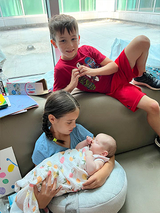Congenital Hyperinsulinism: Eliza’s Story
Congenital Hyperinsulinism: Eliza’s Story
Eliza is a special patient of the Congenital Hyperinsulinism Center at Children’s Hospital of Philadelphia — and not just because she was the 600th child to have a pancreatectomy at the center, which is indeed noteworthy. Eliza is the first of the more that 1,600 patients seen at the center since 1998 to have two different genetic variants in two different genes giving her two types of hyperinsulinism.
But at CHOP, caring for unique cases is not unusual, and Eliza, now 4 months old, is home and is essentially cured.
“She is really special,” says Eliza’s mom, Jessica. “And so is CHOP.”
The journey to CHOP

Doctors at Eliza’s birth hospital in Northern Virginia recognized that she had low blood sugar (hypoglycemia) shortly after birth and put her in the Newborn Intensive Care Unit, but they thought it would return to normal on its own. They even sent Eliza home after six days, assuring Jessica and her husband, Steve, the hypoglycemia was transient. It wasn’t, and when her pediatrician tested her glucose when she was 9 days old, he sent her straight to the emergency room at a regional hospital.
At the larger hospital, doctors were still unsure of a diagnosis or how to treat her. But they did know that CHOP specialized in hypoglycemia and hyperinsulinism and reached out. The HI Center shared protocols to keep Eliza’s glucose levels stable and took genetic samples from Eliza, Jessica and Steve.
“We wanted to go to CHOP right away,” Jessica says. Before long, Eliza was in an ambulance cruising to Philadelphia, her hypoglycemia carefully monitored by an experienced transport team, while Jessica followed in the family’s van.
It didn’t take the HI Center team long to diagnose Eliza with hyperinsulinism, but it wasn’t until genetic test results came back that the type of HI was determined. Knowing the type guides treatment.
Beyond the basics
Hyperinsulinism occurs when the beta cells in the pancreas secrete too much insulin, dropping blood sugar levels to dangerously low levels. There are two types: focal, when the overactive beta cells are concentrated in one small area; and diffuse, where the beta cells are throughout the pancreas.
For Eliza, one gene mutation (ABCC8) showed she had focal HI, which is curable 97% of the time with surgery to remove part of the pancreas with the spot of beta cells excreting too much insulin. The other mutation (KCNJ11) indicated she had diffuse disease, which could mean she may need ongoing treatment.
“I spent a lot of time with Vicki Sanders,” the center’s genetic counselor, Jessica says. “She was so patient with us, taking the time to explain things a few times until we understood. We were nerding out on genetics for a while.”
In addition to explaining Eliza’s unusual genetics, Sanders also talked about possibilities in the future: If the family wanted another baby, what are the chances it would also have HI? Should the family’s two older children, who are free of HI symptoms, be genetically tested to see if they are carriers? And they even learned about Eliza’s odds of passing HI to any of her future children. “Vicki has a depth of knowledge that was really helpful,” Jessica says.
Treating focal disease first
Since focal disease can be cured with surgery, Eliza first underwent an 18F-L-Fluoro-DOPA PET scan to locate the cluster of overactive beta cells in her pancreas to make it easier to remove the lesion during a partial pancreatectomy. On the PET scan, the tail of Eliza’s pancreas lit up. “That was awesome news since that’s the easiest part to remove,” Jessica says.
Surgeon-in-Chief N. Scott Adzick, MD, MMM, operated on Sept. 30, removing about 25% of her pancreas. It was the HI Center’s 600th pancreatectomy — by far the most of any center in the world.

But what about the diffuse disease? Would Eliza’s blood sugar still drop after surgery? Past patients with a KCNJ11 mutation have shown a range of hypoglycemia — from normal to mild to more severe, requiring ongoing treatment or even a near-total pancreatectomy.
‘A real miracle’
Her blood sugar was checked right after surgery: in the normal range. It was checked numerous additional times: all normal. Eliza’s results from the “cure fast” showed she was mostly cured.
“It’s a real miracle that she didn’t have any issues with low blood sugar since the surgery,” Jessica says. “After six weeks at CHOP, they said we could go home. We made it home for Halloween.”
Jessica still tests Eliza a couple of times a week, just for peace of mind. So far, so good. “We don’t take it for granted,” she says. “It’s just amazing how well she’s doing.”
They return to CHOP in March for another cure fast to confirm that Eliza is cured.
A multidisciplinary team effort

The whole family benefited from the multidisciplinary team that cared for Eliza.
In addition to Sanders, there was the nurse coordinator who arranged the transfer to CHOP and the social worker who secured a room in the Ronald McDonald House so the family could be together on weekends, when Steve would bring the family’s two older children, Oakley, 6 and Cora, 8, to Philadelphia. There was Dr. Adzick and the three endocrinologists who managed Eliza during her long stay: Katherine Lord, MD, Winnie Sigal, MD, and Elizabeth Rosenfeld, MD. And the many nurses who cared for Eliza, first in the Harriet and Ronald Lassin Newborn/Infant Intensive Care Unit and later on endocrinology unit.
“What a fantastic team,” Jessica says. “The doctors, the nurses, the attending on call — we had endless opportunities to connect and ask questions. They worked with us to set goals and the plan for each day. Everybody had their part, and they all worked together seamlessly.
We were so blessed to have this amazing hospital just a three-hour drive up the road.